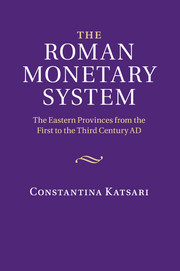Book contents
- Frontmatter
- Contents
- List of charts
- Acknowledgements
- List of abbreviations
- Framing the Roman Monetary System: An Introduction
- 1 Statistics and numismatics
- 2 Planning the financial policy of the Roman state
- 3 Trimetallism and bimetallic laws
- 4 The application of the Quantity Theory of Money to third-century economics
- 5 Roman monetary integration
- 6 Micro-economies
- 7 Metallism vs. chartalism
- Appendix 1 The inscription of Mylasa
- Appendix 2 Excavations finds, coin hoards and museums
- References
- Index
4 - The application of the Quantity Theory of Money to third-century economics
Published online by Cambridge University Press: 01 March 2011
- Frontmatter
- Contents
- List of charts
- Acknowledgements
- List of abbreviations
- Framing the Roman Monetary System: An Introduction
- 1 Statistics and numismatics
- 2 Planning the financial policy of the Roman state
- 3 Trimetallism and bimetallic laws
- 4 The application of the Quantity Theory of Money to third-century economics
- 5 Roman monetary integration
- 6 Micro-economies
- 7 Metallism vs. chartalism
- Appendix 1 The inscription of Mylasa
- Appendix 2 Excavations finds, coin hoards and museums
- References
- Index
Summary
SILVER AND BRONZE MINT OUTPUT
In the previous chapters I suggested that the repeated debasements of the silver coinages and the simultaneous stability of the gold aurei guaranteed the stability of the Augustan monetary system for more than two-and-a-half centuries. However, this stability was risked in the middle of the third century, when the uncertain political situation in the Roman empire undermined the power of the central authorities and eventually destabilised the monetary economy. The emperors in their attempt to increase their revenues resorted to the manipulation of precious-metal coinage through the debasement of the denarius and its eventual replacement with the highly overvalued antoninianus. The lowering of the fineness of the silver coins gave the emperor the means to increase the silver and possibly also the bronze mint output. As we have already seen, military expenditure probably increased during the Severan dynasty and later during the Military Anarchy period, a fact that seems to have affected the silver and bronze mint output during the third century. The production of denarii minted in Rome was intensified during the reigns of Septimius Severus and Caracalla in order to cover the increased needs of the army for coined metal, while the increasing production of silver coins destined to cover military needs became more apparent during and after the reign of Gordian III. It is worth noting, though, that during this Military Anarchy period we detect the extensive use of antoniniani, instead of their silver predecessors, the denarii.
- Type
- Chapter
- Information
- The Roman Monetary SystemThe Eastern Provinces from the First to the Third Century AD, pp. 104 - 166Publisher: Cambridge University PressPrint publication year: 2011



